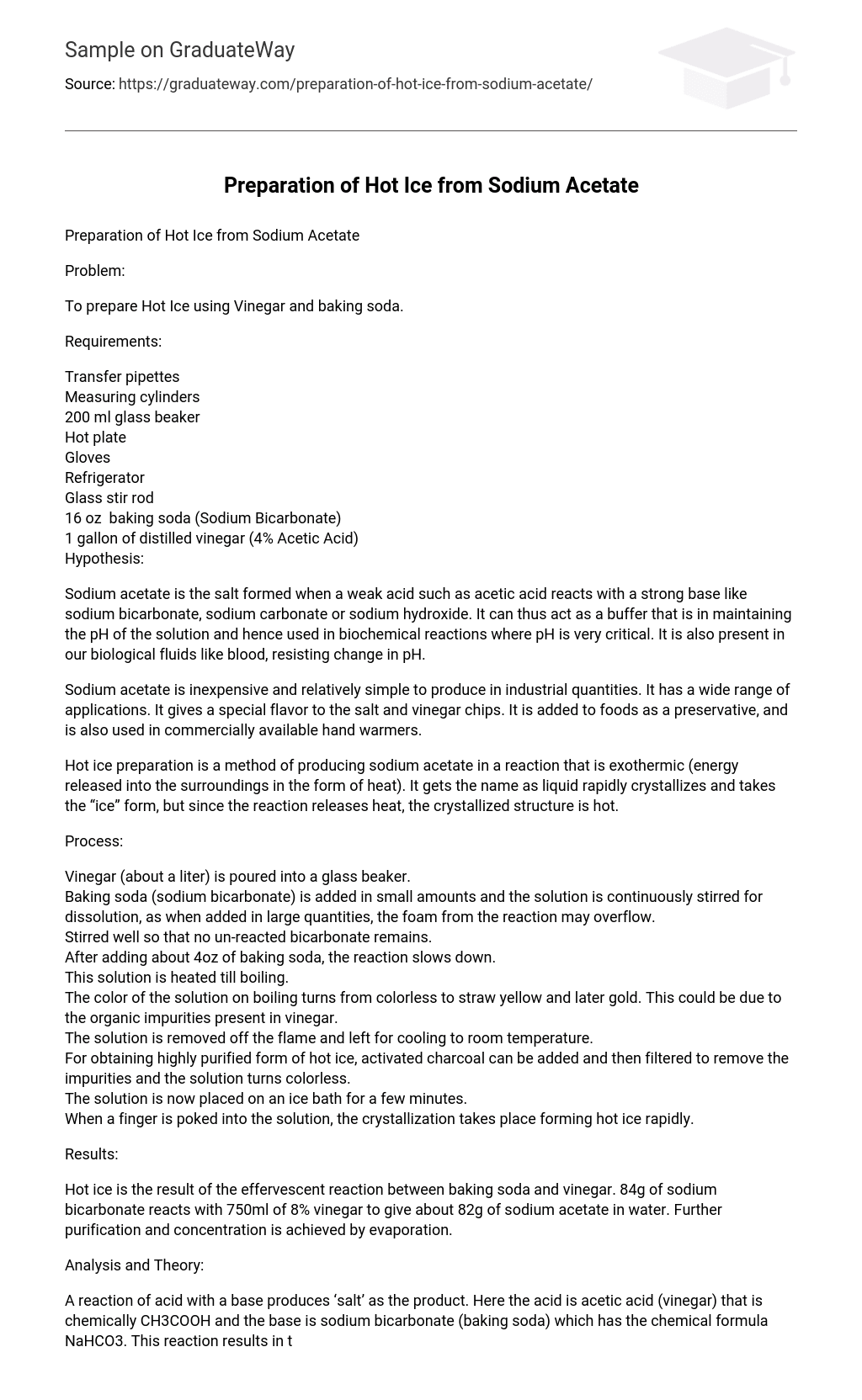Problem
To prepare Hot Ice using Vinegar and baking soda.
Requirements
- Transfer pipettes
- Measuring cylinders
- 200 ml glass beaker
- Hot plate
- Gloves
- Refrigerator
- Glass stir rod
- 16 oz baking soda (Sodium Bicarbonate)
- 1 gallon of distilled vinegar (4% Acetic Acid)
Hypothesis
Sodium acetate is the salt formed when a weak acid such as acetic acid reacts with a strong base like sodium bicarbonate, sodium carbonate or sodium hydroxide. It can thus act as a buffer that is in maintaining the pH of the solution and hence used in biochemical reactions where pH is very critical. It is also present in our biological fluids like blood, resisting change in pH.
Sodium acetate is inexpensive and relatively simple to produce in industrial quantities. It has a wide range of applications. It gives a special flavor to the salt and vinegar chips. It is added to foods as a preservative, and is also used in commercially available hand warmers.
Hot ice preparation is a method of producing sodium acetate in a reaction that is exothermic (energy released into the surroundings in the form of heat). It gets the name as liquid rapidly crystallizes and takes the “ice” form, but since the reaction releases heat, the crystallized structure is hot.
Process
- Vinegar (about a liter) is poured into a glass beaker.
- Baking soda (sodium bicarbonate) is added in small amounts and the solution is continuously stirred for dissolution, as when added in large quantities, the foam from the reaction may overflow.
- Stirred well so that no un-reacted bicarbonate remains.
- After adding about 4oz of baking soda, the reaction slows down.
- This solution is heated till boiling.
- The color of the solution on boiling turns from colorless to straw yellow and later gold. This could be due to the organic impurities present in vinegar.
- The solution is removed off the flame and left for cooling to room temperature.
- For obtaining highly purified form of hot ice, activated charcoal can be added and then filtered to remove the impurities and the solution turns colorless.
- The solution is now placed on an ice bath for a few minutes.
- When a finger is poked into the solution, the crystallization takes place forming hot ice rapidly.
Results
Hot ice is the result of the effervescent reaction between baking soda and vinegar. 84g of sodium bicarbonate reacts with 750ml of 8% vinegar to give about 82g of sodium acetate in water. Further purification and concentration is achieved by evaporation.
Analysis and Theory
A reaction of acid with a base produces ‘salt’ as the product. Here the acid is acetic acid (vinegar) that is chemically CH3COOH and the base is sodium bicarbonate (baking soda) which has the chemical formula NaHCO3. This reaction results in the formation of sodium acetate that is CH3COONa.
Sodium acetate crystals which have a melting point of 58 deg Celsius, melts when boiled up to 100 deg Celsius on cooling this we get a super saturated solution of sodium acetate. On touching this cooled solution, a nucleation center is formed which crystallizes into sodium acetate. The bond forming process during crystallization is exothermic and thus the resulting ice is hot.
There exists an exchange of energy when a material undergoes phase change (result of freezing, melting, boiling). Crystallization occurring in the above described procedure is also a phase change. Supersaturated solutions are unstable mediums as they hold material in larger quantities than they would at a different optimum temperature. So when this unstable system is slightly disturbed, it causes a sudden release of energy as a result of the induced phase change.
Also the since the reaction is exothermic, the products have lower energies than the reactants, the difference in this energy is released as heat energy. The carbonic acid formed splits into water and carbon dioxide which is released in gaseous form resulting in the cooling of the products. This breaking of intermolecular bonds lowers the molecular speed and thus causes a fall in the temperature.
Reaction
CH3COOH à CH3COO- + H+ Acetic acid à Acetate ion + Proton
NaHCO3à Na+ + HCO3- Sodium bicarbonate à Sodium ion + Bicarbonate ion
Na+ + CH3COO- à CH3COONa Sodium ion + Acetate ion à Sodium Acetate
The latent heat of fusion is about 264 – 289 kJ/kg.
H+ + HCO3-à H2CO3 Hydrogen ion + Bicarbonate ion à Carbonic acid
H2CO3à H2O + CO2 Carbonic acid à Water + Carbon dioxide
l





